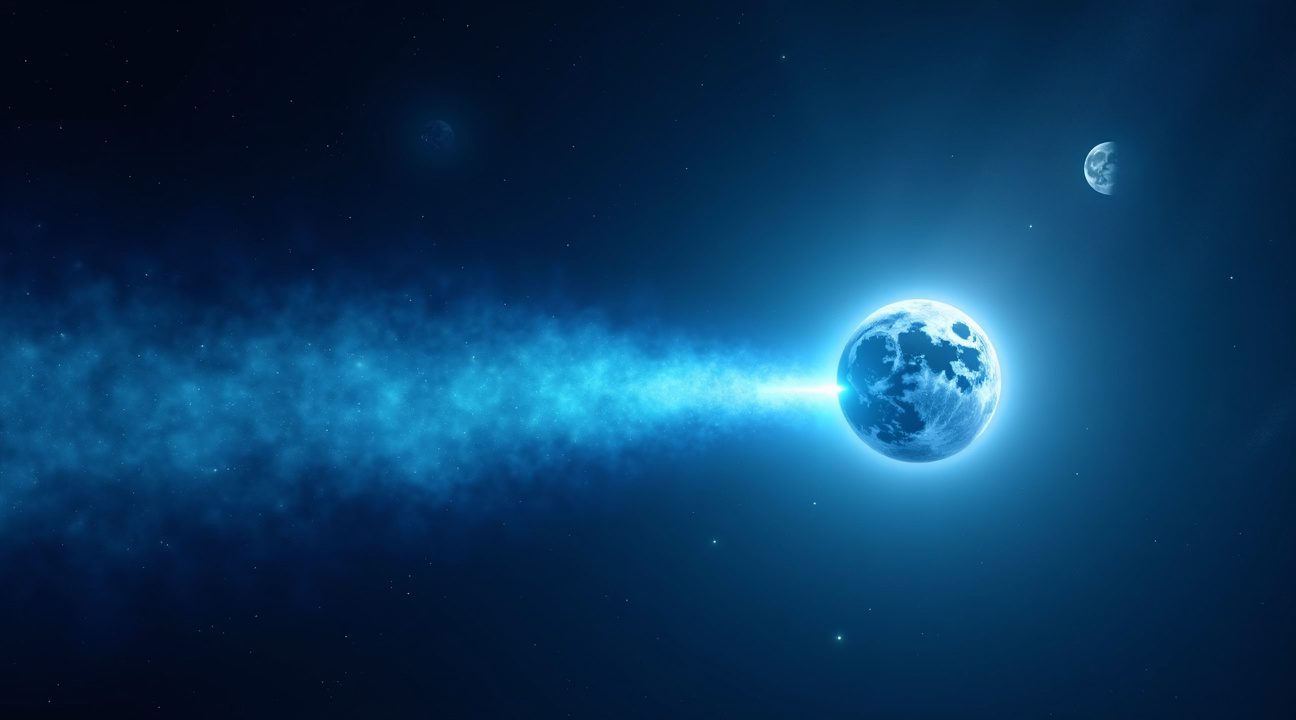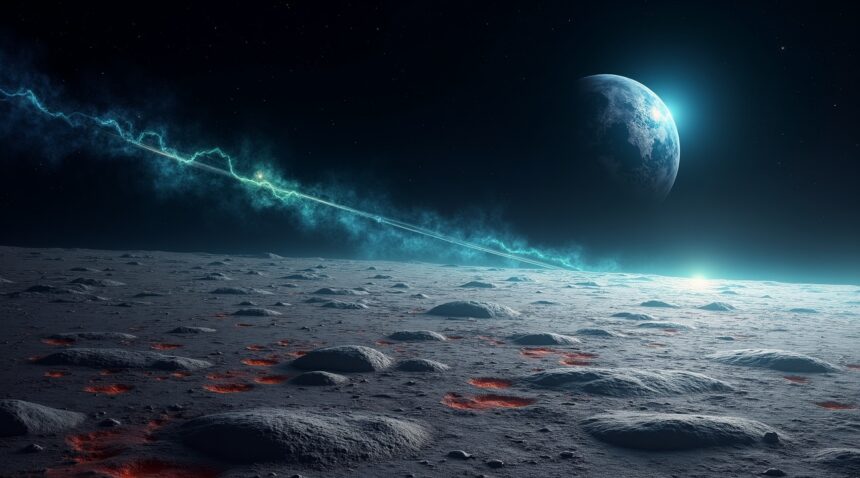Scientists have discovered a surprising phenomenon: the Moon, despite being a dry and airless environment, shows signs of rust formation—specifically hematite—near its poles.
Moon Rusting Phenomenon Explained
This unexpected discovery has intrigued researchers, especially since rust typically forms with the presence of water and oxygen—both of which are scarce or absent on the Moon. The leading explanation centers on a unique interaction involving the Earth and its atmosphere.
How “Earth Wind” Reaches the Moon
- Earth’s oxygen reaches the Moon through a phenomenon dubbed “Earth wind.” During specific phases of the Moon’s orbit, particularly near the full moon, oxygen ions from Earth’s upper atmosphere are funneled toward the Moon via Earth’s magnetotail.
- This process allows iron on the lunar surface to oxidize, despite the Moon’s lack of atmosphere, creating rust-like hematite.
Timing and Orbital Influence
- The Moon rusts primarily during full moon phases when it enters Earth’s magnetotail for about five days. This region blocks the fast-moving solar wind and allows oxygen ions from Earth to strike the Moon’s surface more effectively.
- This protective shield from solar wind enables oxidative reactions that wouldn’t typically occur in open space.
Impact of Solar Wind
- Solar wind cannot prevent existing rust formation. While hydrogen from solar wind usually reduces rusting by stripping away oxygen atoms, it is too low-energy during these phases to undo the established hematite molecules.
Role of Lunar Water
- Trace amounts of water enable the rusting process. Water molecules bound to lunar dust and minuscule ice deposits in shaded polar craters provide just enough hydrogen and oxygen for hematite to form.
Distribution Confirms Earth’s Influence
- Rust distribution patterns confirm Earth’s influence. There’s a higher prevalence of rust on the Moon’s near side—the hemisphere facing Earth—which supports the theory that Earth-sourced oxygen plays a central role.
- Yet, rust found on the far side indicates there may be other contributing factors or unknown mechanisms at work.
Learn more through this NASA article explaining the Moon’s rust, where experts delve deeper into this unexpected lunar phenomenon.
Earth’s Oxygen is Somehow Reaching the Moon and Creating Rust
Scientists have discovered something extraordinary happening on the Moon’s surface – hematite, commonly known as rust, exists in significant quantities near the lunar poles. This discovery challenges everything researchers previously understood about lunar chemistry, since rust typically requires water and oxygen to form, yet the Moon maintains an extremely dry surface with virtually no atmosphere.
The Earth Wind Phenomenon
The explanation lies in a fascinating process called “Earth wind” – a continuous stream of oxygen ions that escape from Earth’s upper atmosphere and travel through space. These charged particles don’t simply float randomly through the solar system. Instead, they follow a specific path through Earth’s magnetotail, which extends far beyond our planet like an invisible cosmic highway.
Earth’s magnetotail represents a long extension of our planet’s magnetic field that stretches approximately 200,000 miles into space, reaching well beyond the Moon’s orbital distance. The Moon’s gradual movement brings it directly into this magnetotail region during specific phases of the lunar cycle.
Lunar Oxidation During Full Moon Phases
For approximately five days during each full Moon phase, our satellite moves into Earth’s magnetotail and experiences protection from the solar wind. This shielding creates perfect conditions for Earth-originating oxygen ions to interact directly with the lunar surface. During these critical periods, iron particles embedded in the lunar soil undergo chemical reactions with the incoming oxygen ions.
The oxidation process occurs when these Earth-derived ions make contact with surface iron deposits, particularly in permanently shadowed regions near the lunar poles. Recent missions, including India’s Chandrayaan-3, have provided valuable data about these chemical processes occurring on the Moon’s surface.
This mechanism explains how hematite forms in an environment previously thought impossible for rust creation. The discovery revolutionizes our understanding of planetary interactions within the Earth-Moon system and demonstrates that our planet’s influence extends much further than scientists previously imagined. The process continues cyclically, with each full Moon phase bringing fresh opportunities for oxygen transfer and subsequent lunar oxidation.

How Scientists Made This Shocking Discovery on an Airless World
I can trace this remarkable discovery back to 2008, when India’s Chandrayaan-1 mission carried an extraordinary piece of NASA-supplied equipment to lunar orbit. The Moon Mineralogy Mapper, known as M3, became the detective that would uncover one of the most puzzling chemical mysteries in our solar system.
The Unexpected Spectral Signatures
M3’s sophisticated sensors captured something that shouldn’t have existed on our airless satellite. The instrument detected clear spectral signatures of hematite—a form of iron oxide commonly known as rust—concentrated specifically near the lunar poles. I find this discovery particularly striking because these polar regions represent some of the most inhospitable environments for rust formation imaginable.
The spectral data revealed oxidized iron minerals that stood out dramatically from the typical iron signatures found elsewhere on the Moon. Scientists had expected to find metallic iron in lunar regolith, but the presence of hematite created an immediate puzzle. The Moon lacks the traditional ingredients for rust formation: a substantial atmosphere containing oxygen and liquid water.
Challenging Scientific Assumptions
This discovery forced researchers to reconsider fundamental assumptions about lunar chemistry. For decades, scientists viewed the Moon as chemically inactive due to its airless environment. Mars provides a stark contrast—the Red Planet exhibits extensive rust formation because it once hosted liquid water and maintains a thin atmosphere containing oxygen.
The M3 data showed that lunar hematite formation defied conventional understanding. Unlike Earth, where iron oxidizes readily in the presence of water and atmospheric oxygen, or Mars, where ancient water flows and atmospheric conditions enabled widespread rust formation, the Moon presented an entirely different scenario. The detection of these oxidized iron minerals specifically at the poles suggested that unique processes must be occurring in these regions.
Scientists had to grapple with the fact that their instruments were detecting genuine rust on a world where such formation should be impossible. The spectral signatures were unmistakable—the Moon was hosting chemical reactions that traditional planetary science couldn’t easily explain. This discovery highlighted how much we still don’t understand about our celestial companion, even after decades of study and multiple missions.
The implications extended beyond simple curiosity. If rust could form on an airless world like the Moon, it suggested that oxygen transport mechanisms and chemical processes in space might be far more complex than previously understood. The Moon Mineralogy Mapper had essentially opened a new chapter in lunar science, one that would require scientists to develop entirely new theories about how oxidation occurs in the harsh environment of space.
Why Solar Wind Should Have Prevented This Rust Formation
The presence of rust on the Moon defies conventional expectations, particularly when considering the constant assault of solar wind particles. I find this phenomenon fascinating because solar wind consists primarily of hydrogen ions that should theoretically prevent any rust formation from occurring.
Solar wind creates a reducing environment that actively works against oxidation processes. Hydrogen possesses strong reducing properties, meaning it typically suppresses oxygen’s ability to react with iron and form rust. The Moon receives this hydrogen bombardment continuously, creating conditions that should strip away oxygen and prevent hematite formation entirely.
Recent laboratory experiments have revealed a crucial distinction that helps explain this apparent contradiction. Scientists discovered that low-energy hydrogen ions—exactly the type delivered by solar wind—don’t significantly reverse existing oxidation processes. These gentle particles lack the energy needed to break apart already-formed hematite molecules and restore iron to its metallic state.
High-Energy Particles Make the Difference
The key lies in understanding energy levels and their impact on chemical reactions. Laboratory studies demonstrate that only high-energy hydrogen ions can effectively reduce hematite back to metallic iron. These powerful particles carry enough energy to break the strong bonds between iron and oxygen atoms. Interestingly, Earth’s magnetosphere generates these high-energy hydrogen particles, creating a stark contrast to the gentler solar wind bombardment.
This energy distinction provides a compelling explanation for why rust persists in certain lunar regions despite constant hydrogen exposure. The Moon’s orbital position relative to Earth’s magnetic field becomes critical in determining where different energy particles can reach the surface.
Earth’s magnetotail plays a crucial role in directing oxygen ions specifically toward the lunar poles. This magnetic channel acts like a cosmic highway, funneling oxygen-rich particles from Earth’s upper atmosphere directly to specific regions of the Moon. The M3 instrument aboard India’s Chandrayaan-1 mission detected hematite concentrations that align perfectly with these polar regions where Earth’s magnetotail delivers its oxygen payload.
Additional orbital studies have corroborated these findings, showing that rust distribution follows predictable patterns based on magnetic field interactions. The polar concentration of hematite supports the theory that Earth-sourced oxygen, rather than local processes, drives this unexpected lunar oxidation.
The solar wind’s inability to prevent rust formation becomes even more intriguing when considering timing factors. Lunar missions have revealed that oxidation occurs during specific periods when the Moon passes through Earth’s magnetotail, temporarily shielding certain regions from direct solar wind exposure.
During these protected periods, Earth-delivered oxygen ions can react with lunar iron without immediate interference from reducing hydrogen particles. The process creates a window of opportunity for rust formation that persists even after the Moon exits Earth’s magnetic protection and resumes full solar wind exposure.
This discovery challenges previous assumptions about planetary chemistry and demonstrates how complex interactions between celestial bodies can create unexpected chemical environments. The Moon’s rust formation represents a unique case where proximity to Earth creates conditions that wouldn’t exist on an isolated celestial body.
Understanding these processes has implications beyond lunar science. Scientists now recognize that planetary magnetic fields can influence the surface chemistry of nearby objects in ways previously unconsidered. This knowledge could prove valuable for future space exploration missions and our understanding of how planets interact with their immediate cosmic environment.
The persistence of lunar rust despite solar wind bombardment illustrates the intricate balance between competing chemical forces in space. Low-energy hydrogen ions from solar wind simply cannot overcome the stability of already-formed hematite, allowing Earth’s oxygen contribution to create lasting changes on the lunar surface.
The Water Mystery: How Trace Amounts May Enable Rust
The Moon’s apparent lack of liquid water initially puzzled scientists when they discovered rust formations across its surface. However, researchers now believe minute quantities of water exist in forms previously overlooked. These trace amounts appear in two primary locations: water molecules chemically bound to lunar surface materials and water ice deposits trapped within permanently shadowed polar craters.
Micrometeorite impacts play a crucial role in this oxidation process. When these fast-moving space debris particles strike the lunar surface, they generate enough energy to release water molecules that have been chemically bound to lunar dust particles. The impacts also create temporary conditions where these freed water molecules can interact with iron-bearing minerals before being lost to space.
Earth’s magnetosphere contributes another essential component to this rust formation mechanism. During specific orbital alignments, the Moon passes through Earth’s magnetic tail, where it encounters oxygen ions that originated from our planet’s upper atmosphere. These Earth-derived oxygen particles combine with the trace water molecules to create the perfect chemical cocktail for oxidation reactions.
Laboratory Evidence and Polar Concentrations
Laboratory simulations have provided compelling evidence for this theory. Scientists recreated lunar surface conditions using samples that mimicked the Moon’s iron-rich composition, then exposed these materials to scenarios involving minimal solar wind, Earth-originating oxygen ions, and trace water amounts. The results consistently produced rust patterns that matched observations from lunar missions.
The evidence becomes even more convincing when examining specific locations where rust concentrations appear strongest:
- Permanently shadowed craters near the lunar poles show the highest rust concentrations
- Areas that regularly pass through Earth’s magnetosphere display more oxidation than regions constantly exposed to solar wind
- Surface chemistry analysis reveals rust formation correlates with regions where water ice deposits are most likely to exist
- Molecular water signatures detected by orbital missions align with areas showing the most significant iron oxidation
These shadowed craters serve as natural repositories where water ice can accumulate over millions of years without sublimating into space. When occasional impacts or thermal cycling occur, minute amounts of this water ice convert to vapor, providing just enough moisture for surface chemistry reactions to proceed.
The timing of these processes matters significantly. Rust formation appears most active during periods when the Moon travels through Earth’s magnetic field lines, suggesting that the combination of Earth-sourced oxygen and locally available water creates optimal conditions for oxidation. During these windows, even the smallest water molecules can participate in chemical reactions that would be impossible under normal lunar conditions.
Recent findings from lunar missions have strengthened this theory by detecting both water signatures and rust formations in similar locations. The correlation between these discoveries supports the hypothesis that trace water amounts, whether from bound molecules or ice deposits, provide sufficient hydration for oxidation processes when combined with Earth-derived oxygen.
This discovery challenges previous assumptions about what constitutes enough water for chemical reactions in space environments. The Moon demonstrates that even the most minimal water presence can drive significant surface chemistry changes when other conditions align properly. Understanding these trace water interactions has implications for future lunar exploration and resource utilization planning.
Strange Patterns Reveal More Earth-Moon Connection Than Expected
Scientists have discovered fascinating patterns in the distribution of hematite across the Moon’s surface that strengthen the case for Earth’s role in lunar rust formation. The concentration of rust appears noticeably higher on the Moon’s near side—the hemisphere that perpetually faces our planet—compared to the far side that remains hidden from Earth’s view.
Uneven Distribution Points to Earth’s Influence
This asymmetrical pattern of hematite distribution provides compelling evidence that oxygen ions streaming from Earth drive the primary rust formation process. The near side receives direct exposure to Earth’s magnetotail and the charged particles it carries, while the far side benefits from natural shielding provided by the Moon’s bulk. The contrast between these regions demonstrates how Earth’s magnetic field extends its influence far beyond what scientists previously understood.
Earth wind—the stream of charged particles escaping our planet’s upper atmosphere—reaches the Moon’s Earth-facing surface with significantly greater intensity than areas on the far side. This difference in exposure correlates directly with the observed hematite concentrations, suggesting a clear cause-and-effect relationship between terrestrial oxygen and lunar oxidation.
Unexpected Discoveries Challenge Current Understanding
However, the story becomes more intriguing when examining the Moon’s far side. Scientists have detected small but measurable amounts of hematite even in regions that should theoretically receive minimal Earth-originating oxygen exposure. These findings introduce a puzzling element to the Moon’s evolution and challenge existing models of how rust forms in space environments.
The presence of hematite on the far side suggests unknown mechanisms may enable oxidation processes even without direct Earth wind exposure. Researchers now explore whether reflected particles, secondary interactions, or entirely different oxidation pathways might contribute to rust formation in these shielded regions. The magnetic influence of Earth’s field may extend farther and operate through more complex channels than current theories predict.
These anomalies highlight the intricate nature of oxidation processes occurring across the lunar surface. The varying concentrations between hemispheres reveal that multiple factors likely contribute to hematite formation, with Earth’s oxygen playing the dominant but not exclusive role. Future missions like Chandrayaan-3 may provide additional data to solve these remaining mysteries about lunar rust distribution patterns.
Sources:
ScienceAlert, “The Moon Is Rusting, And It’s All Earth’s Fault”
NASA, “The Moon Is Rusting, and Researchers Want to Know Why”
Phys.org, “Has Earth’s oxygen rusted the Moon for billions of years?”
The Week, “The moon is rusting”
NDTV, “Moon Is Rusting: Scientists Stunned By Hematite Discovery…”


